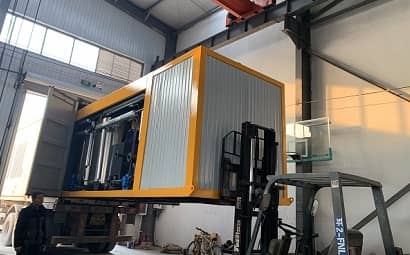The technical feature of the simultaneous gravel sealing technology is that one equipment can spread the bonding material and stone at the same time. The asphalt and stone must be combined within one second. The temperature of the hot asphalt is 140°C when the bonding material is sprayed, and the temperature can be guaranteed to be above 120°C during bonding. The asphalt temperature drops very little. At this time, the fluidity of the asphalt binder is still very good, and the bonding area with the stone is large, which enhances the bonding with the stone. The strength of the stone bond. The traditional surface sealing technology generally uses two different equipments and two processes for spreading construction. Such a long construction time interval will cause the temperature of the asphalt to drop by about 70°C, and the bonding effect between the stone and the asphalt will be poor, resulting in a large loss of stone and affecting the performance of the sealing layer.
Synchronous gravel sealing technology has the following characteristics:


(1) Better waterproofness. The simultaneous spraying of bonding materials in the gravel seal layer can fill the slight cracks in the road surface, reduce the reflective cracks in the road surface, and increase the crack resistance of the road surface, thereby improving the anti-seepage performance of the road surface.
(2) Good adhesion and anti-slip properties. Asphalt or other binding materials bond the aggregate to the original road surface. 1/3 of the aggregate can directly contact the tires. Its roughness increases the friction coefficient with the tires, improving the adhesion and adhesion of the road surface. Slip resistance.
(3) Wear resistance and durability. The gravel and asphalt spread simultaneously form an asphalt binder, and 2/3 of the height of the gravel particles sinks into the asphalt, which increases the contact area between the two, and a concave surface can be formed due to the gross attraction force of the asphalt binder. It is closely combined with the gravel to prevent the loss of gravel, so the synchronous gravel seal has good wear resistance and durability. This is also one of the important factors for synchronous gravel sealing technology to extend the service life of roads.
(4) Economy. The cost-effectiveness of simultaneous gravel sealing is significantly better than other road surface treatment methods, thus greatly reducing road maintenance costs.
(5) The construction process is simple, the construction speed is fast, and traffic can be opened in time.
 Albanian
Albanian  Russian
Russian  Arabic
Arabic  Amharic
Amharic  Azerbaijani
Azerbaijani  Irish
Irish  Estonian
Estonian  Odia (Oriya)
Odia (Oriya)  Basque
Basque  Belarusian
Belarusian  Bulgarian
Bulgarian  Icelandic
Icelandic  Polish
Polish  Bosnian
Bosnian  Persian
Persian  Afrikaans
Afrikaans  Tatar
Tatar  Danish
Danish  German
German  French
French  Filipino
Filipino  Finnish
Finnish  Frisian
Frisian  Khmer
Khmer  Georgian
Georgian  Gujarati
Gujarati  Kazakh
Kazakh  Haitian Creole
Haitian Creole  Korean
Korean  Hausa
Hausa  Dutch
Dutch  Kyrgyz
Kyrgyz  Galician
Galician  Catalan
Catalan  Czech
Czech  Kannada
Kannada  Corsican
Corsican  Croatian
Croatian  Kurdish (Kurmanji)
Kurdish (Kurmanji)  Latin
Latin  Latvian
Latvian  Lao
Lao  Lithuanian
Lithuanian  Luxembourgish
Luxembourgish  Kinyarwanda
Kinyarwanda  Romanian
Romanian  Malagasy
Malagasy  Maltese
Maltese  Marathi
Marathi  Malayalam
Malayalam  Malay
Malay  Macedonian
Macedonian  Maori
Maori  Mongolian
Mongolian  Bengali
Bengali  Myanmar (Burmese)
Myanmar (Burmese)  Hmong
Hmong  Xhosa
Xhosa  Zulu
Zulu  Nepali
Nepali  Norwegian
Norwegian  Punjabi
Punjabi  Portuguese
Portuguese  Pashto
Pashto  Chichewa
Chichewa  Japanese
Japanese  Swedish
Swedish  Samoan
Samoan  Serbian
Serbian  Sesotho
Sesotho  Sinhala
Sinhala  Esperanto
Esperanto  Slovak
Slovak  Slovenian
Slovenian  Swahili
Swahili  Scots Gaelic
Scots Gaelic  Cebuano
Cebuano  Somali
Somali  Tajik
Tajik  Telugu
Telugu  Tamil
Tamil  Thai
Thai  Turkish
Turkish  Turkmen
Turkmen  Welsh
Welsh  Uyghur
Uyghur  Urdu
Urdu  Ukrainian
Ukrainian  Uzbek
Uzbek  Spanish
Spanish  Hebrew
Hebrew  Greek
Greek  Hawaiian
Hawaiian  Sindhi
Sindhi  Hungarian
Hungarian  Shona
Shona  Armenian
Armenian  Igbo
Igbo  Italian
Italian  Yiddish
Yiddish  Hindi
Hindi  Sundanese
Sundanese  Indonesian
Indonesian  Javanese
Javanese  Yoruba
Yoruba  Vietnamese
Vietnamese  Hebrew
Hebrew  Chinese (Simplified)
Chinese (Simplified)







